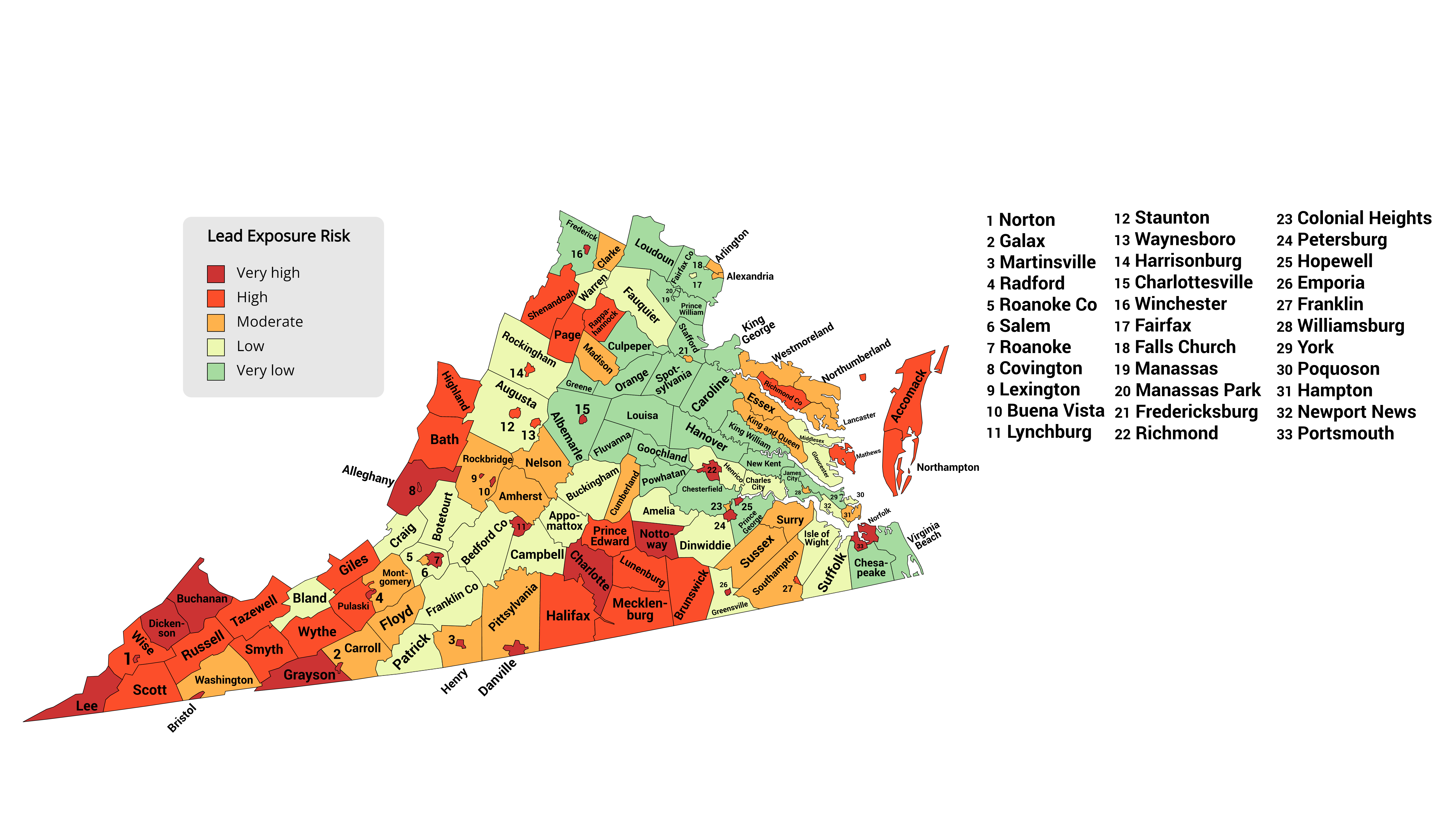
Children may be exposed to lead from old paint, water or other sources in their environment. Lead exposure can lead to lowered IQ, developmental delays, and attention problems. Most children with lead in their blood don't show any sign that they are sick. The best way to find out if your child has been exposed to lead is with a simple blood test from a health care provider. Protect your family from lead poisoning by learning more about where to find lead and how to prevent exposure.
Lead Exposure Risk by County
Every child is at risk of being exposed to lead. However, there are some areas in Virginia where the lead exposure risk may be higher than other areas. Review the Lead Exposure Risk map to determine lead exposure risk in your area. Talk to your health care provider about getting your children tested for lead in their blood if:
- You think they may have been exposed to lead.
- You live in a moderate, high, or very high risk area for lead exposure.
- Your children are at high risk for lead exposure, regardless of where you live in Virginia.
Lead Poisoning Prevention Information
What are the health impacts of lead exposure?
Exposure to lead in young children can cause:
- Damage to the brain and nervous system.
- Hearing and speech problems.
- Attention and behavior problems.
- Delayed growth and development.
Over time, these health issues can lead to:
- Decreased IQ.
- Inability to pay attention.
- Decreased performance in school.
- Increased aggressive behavior.
Why are young children the most at risk?
Children under the age of six are the most at risk for the harmful effects of lead exposure because:
- Their bodies are still rapidly growing and developing.
- They are more likely to be exposed to lead from crawling on the floor and hand-to-mouth behaviors.
- Their bodies absorb lead more easily than the bodies of adults.
Some populations are at higher risk of lead poisoning, but all children can be exposed to lead and harmed by lead.
How are children exposed to lead?
- Paint. The main source of household lead exposure is from lead in paint, found in houses built before 1978. Dust and flaking paint, especially around friction surfaces such as doorways and window sills, is a major source of lead for children.
- Soil. Lead may be present in soil surrounding old buildings that were painted with lead paint, and close to roads, where lead from gasoline may have settled. You child can become exposed to lead if they play in bare soil and put their hands and feet in their mouths.
- Water. Lead may be in the water in older homes where the pipes, fixtures, or solder may contain lead. The VDH Office of Drinking Water can provide further information about water quality in Virginia.
- Adult professions and hobbies. Some professions and hobbies may expose parents to lead, which can then be brought to the home on their clothing. Visit our Information for Adults page for more information about these sources.
- Consumer products. Many consumer products, including some toys, jewelry, imported spices, cosmetics, medicines, and old vinyl blinds, may include lead.
- Traditional medicines. Some traditional medicines that have been known to contain lead include:
-
- Azarcon, Ba-baw-san, Bali Gholia, Daw Tway, Ghasard, Greta, Kandu, Paylooah
-
- Traditional cosmetics. Some traditional cosmetics that have been known to contain lead include:
-
- Kajal, Kohl, Sindoor, Surma
-
For more information about recalled products due to lead contamination, visit the U.S. Consumer Product Safety Commission website.
Is there lead in food?
There are certain food sources that have a higher risk of containing lead:
- Some imported spices can contain lead, such as:
-
- Turmeric, cinnamon, curry, massala, adjika, kviteli kvavali, svanuri marili, kharcho suneli, utskho suneli.
-
- Leafy greens and other produce can become a source of lead exposure if they are grown in soil contaminated with lead, or grown in areas where lead particles may settle.
- Meat can become contaminated with lead if the animal is hunted with lead shot.
How can I keep my family safe from lead in the environment?
Simple prevention measures can keep you and your family safe from sources of lead in your home. If you are pregnant, you should follow the same advice to avoid exposing yourself to lead, which can be passed on to your baby.
- Keep a clean environment by removing shoes when entering the house.
- Wet-wipe and wet-mop (especially around window sills and house entrances).
- Regularly wash children’s hands and toys. This can prevent lead exposure from lead dust in older houses where lead-based paint has been used.
- Prioritize cleaning areas of the home where children under the age of three spend most of their time.
- Prevent children from playing in bare soil, or cover it with mulch or wood chips or by planting grass. Avoid planting gardens close to old structures or high traffic areas.
- Wash children’s hands and change their clothes after they play outside to prevent bringing lead-contaminated soil into the house.
- Run the water for about 60 seconds before use, and use cold water only to cook, drink, and mix baby formula. This can help reduce exposure to lead if it is in your plumbing and contaminating your water.
It is important to use lead-safe practices when doing renovations on older homes. You can learn more about how to protect your family during home renovations at our page for homeowners.
Adults who are exposed to lead through work or hobbies should take steps to avoid bringing lead into the home by:
- Changing clothes immediately after coming home.
- Taking off shoes before entering the home.
- Showering and washing hands before interacting with children.
- Washing clothes separately from the rest of the family's clothes.
- Making sure children under 6 and pregnant women do not eat meat harvested with lead bullets.
How do I know if my child has been exposed to lead?
Testing your child’s blood is the best way to determine whether your child has been exposed to lead. An initial screening is often done with blood collected from a capillary test (finger prick) by a health care provider. If an elevated level of lead is detected, a follow-up venous test (blood collected from a vein) may be needed. Venous tests are more accurate, so they are often used to confirm a capillary blood lead level. See Virginia's blood lead testing policy below:
Children should be screened for lead at 12 and 24 months if they meet any of the following criteria. If not previously tested, children up to 72 months should be tested if they meet any of the following criteria:
-
-
- Eligible for or receiving benefits from Medicaid or WIC
- Living in or regularly visiting housing or child care facility built before 1960
- Living in or regularly visiting housing built before 1978 with peeling or chipping paint or recent (within the last 6 months), ongoing or planned renovations
- Living with or regularly visiting housing in which one or more persons have evidence of lead exposure
- Living with an adult whose job or hobby involves exposure to lead
- Living near an active lead smelter, battery recycling plant, or other industry likely to release lead
- The child’s parent or guardian requests the child’s blood be tested due to any suspected exposure
- Recent refugee, immigrant, or child adopted from outside the U.S.
-
What do I do if my child has lead in his or her blood?
The state of Virginia has guidelines for healthcare providers to follow for cases of children with blood lead levels greater than or equal to 3.5 μg lead/dL blood (μg/dL = the units for measuring lead in blood). The follow-up guidelines include interventions based on the child's blood lead level. Interventions at lower blood lead levels include education about preventing lead exposure and follow-up testing, and at higher blood lead levels may include medical intervention. There is no medical treatment for children whose blood lead levels are below 45 μg/dL, so it is important to find and safely remove the source of lead from the child's environment.
If your child has a blood lead level lower than 10 μg/dL:
-
- Learn about potential sources of lead exposure.
- Safely remove possible sources of lead.
- Consider all households or locations where your child spends time (including daycare or grandparents' houses).
- Lead levels will go down once the child is no longer exposed to lead.
- Use lead-safe practices in your household.
- Talk to your doctor or health care provider about when to have your child's blood tested again.
- Feed your child a healthy and nutritious diet (anemia increases the risk of lead poisoning).
- Increase calcium, iron, and vitamin C in their diet - this can help prevent the absorption of lead in their body.
- Avoid fried and fatty foods.
- Have the other children in the home under the age of 6 tested.
- Someone from your local health department may call your family. They will provide education and information on follow-up blood lead testing.
If your child has a blood lead level of 10 μg/dL or higher, a case manager from your local health department will work with you on the next steps. These next steps may include a having your home tested for sources of lead by a professional.
What are the dangers of lead exposure during pregnancy?
Lead exposure during pregnancy can be harmful for both the mother and the baby. It can cause:
- Increased risk of stillbirth and miscarriage.
- Increased risk of the baby being born preterm.
- Increased risk of the baby having a low birthweight.
- Damage to the baby’s brain, kidneys, and nervous system.
- Future developmental and learning problems in the baby.
How can I keep myself and my baby safe from the harmful effects of lead?
There are some simple steps you can take to protect yourself and your baby from the harmful effects of lead, such as:
- Wet-wipe and wet-mop around window sills and home entrances.
- Wash your hands often.
- Remove your shoes before entering your home.
- If a family member has a job or hobby that exposes them to lead, ask them to take off their shoes before coming inside and change their clothes immediately after coming home. Learn more about jobs or hobbies that increase risk of lead exposure here.
- Do not remodel your home, do not sand paint, and do not remove paint with a heat gun while you are pregnant.
How do I know if I am at risk of being exposed to lead?
You are at an increased risk of being exposed to lead if you:
- Live in a home built before 1978.
- Are a recent immigrant or refugee.
- Use imported pottery or ceramics to prepare and store food.
- Have old plumbing and pipes in your home.
- Live with someone who has a job or hobby that may expose them to lead, such as welding, metalwork, building renovation, stained glass, casting, or soldering.
- Developed pica (eating or putting non-food items in your mouth) during your pregnancy.
- Use traditional folk remedies or cosmetics.
If you are pregnant or breastfeeding and fall under any of these risk categories, ask your health care provider to give you a blood lead test.
Recall Information
Please browse the product recall details in the "Recall Details" tab to the right to learn:
- What products are currently recalled.
- Recommendations for parents on next steps to take if the product has been purchased or is in use.
- Where and when the products were sold.
- CDC recommendations for health care providers.
Recall information will be maintained on this website for one year from the recall date.
New York Wholesale Group of Hicksville, NY is recalling Zaarah Herbals Shatavari Powder, to the consumer/user level because it has the potential to be contaminated with elevated levels of lead.
Zaarah Herbals Shatavari Powder was distributed to retailers located in New York, New Jersey, and Connecticut between 10/21/2022 and 04/15/2024. Product is packaged in clear 100g (3.5oz) jars with a gold lid. The name ZAARAH HERBALS SHATAVARI POWDER prominently displayed on the front of the jar. The UPC is 63502899940. Product codes included in the recall are Batch No: SR 04 Mfd. Date: JULY/2022 and can be found on the back panel of the bottle.
Consumers who have purchased this product should not consume it and can return to the place of purchase for a full refund. Consumers with questions may contact the company at 1-800-516-7606 Monday through Friday from 10:00am to 6:00pm EST.
CDC encourages health care providers to:
- Raise awareness among parents about these products.
- Consider testing children for lead exposure from these and other sources.
For more information please visit the FDA recall announcement.


Product images
References: FDA recall announcement, CDC Childhood Lead Poisoning Prevention Program
Recall date: February 20, 2025
This recall involves Rebecca’s Toys & Prizes bowling pin sipper cups. The cups are white with red tape on the neck and a red plastic cap. The words “ITEM NO. PG1045”, the brand name and the firm’s address are printed on a white label located on the side of the sipper cup. The red tape on the bowling pin sipper cups contains levels of lead that exceed the federal lead content ban.
Consumers should immediately take the recalled cups away from children and stop using them. Contact Nazzaro for a full refund. Nazzaro is contacting all known purchasers directly.
Health care providers should:
- Raise awareness among parents about these products.
- Consider testing children for lead exposure from these and other sources.
For more information please visit the Consumer Product Safety Commission recall announcement.
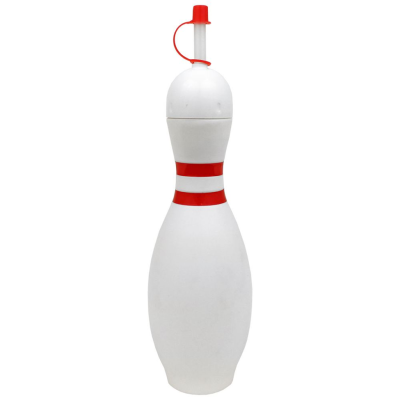
Product image of recalled item
Reference: CPSC recall announcement
The FDA announced that New York Wholesale group is recalling several types of herbal powders, because they can be contaminated with lead and arsenic. The products included are:
- Zaarah Herbals Rasayan Churan
- Zaarah Herbals Gurmar Powder
- Zaarah Herbals Vasaka Powder
- Zaarah Herbals Bhringraj Powder
These products were distributed to retailers located in New York, New Jersey, Connecticut and California between 12/20/2024 and 01/07/2025. The recalled products are packaged in clear 100g (3.5oz) jars with a gold lids. The name of the product is prominently displayed on the front of the jars. Visit the FDA recall announcement for the product codes included in the recall.
Consumers who have purchased these products should not consume them and can return to the place of purchase for a full refund. Consumers with questions may contact the company at 1-800-516-7606 Monday through Friday from 10:00am to 6:00pm EST.
CDC encourages health care providers to:
- Raise awareness among parents about these products.
- Consider testing children for lead exposure from these and other sources.
For more information visit the FDA recall announcement.

Product image: Gurmar Powder
References: FDA recall announcement, CDC Childhood Lead Poisoning Prevention Program
Recall date: May 01, 2025
This recall involves Dlesot Snap Hair Clips. The metal hair clips are in a multipack of 120. The clips were sold in a variety of colors and patterns and measure about 1.2 inches. The FNSKU number “X00RCTBRH” and “Made in China” are printed on a white label located on the plastic container box the clips are stored in. The painted hair clips contain levels of lead that exceed the federal lead paint ban, posing a lead poisoning hazard to children.
Consumers should immediately take the recalled hair clips away from children, stop using them and contact YFLGOTOO. Consumers will need to provide a picture of disposal, to receive the remedy. Amazon is contacting all known purchasers directly.
Health care providers should:
- Raise awareness among parents about these products.
- Consider testing children for lead exposure from these and other sources.
For more information please visit the Consumer Product Safety Commission recall announcement.
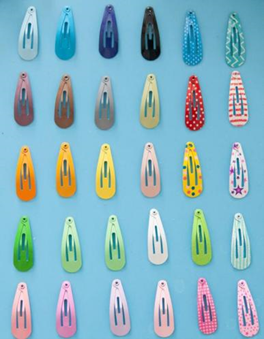
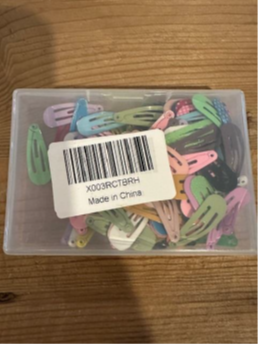
Product images of recalled item
Reference: CPSC recall announcement
Recall date: May 29, 2025
This recall involves multiple different kitchen faucet brands: BASDEHEN, KICIMPRO, and VFAUOSIT, all sold on Amazon. The recalled faucets were tested and found to contain lead that can leach into water at levels that can be particularly harmful to infants and young children. The BASDEHEN faucets were also found to leach other contaminants.
- BASDEHEN: Model number CFDTTH-000-YGH. The faucets are matte black single-handle kitchen faucets with 360° swivel, spring spout design, detachable spray, optional mounting plate and single-hole installation.
- KICIMPRO: Model number KM800-01-06BN. The faucets are brushed nickel, single-handle kitchen faucets with a pull-down detachable spray and single-hole installation.
- VFAUOSIT: Model number 06BNV. The faucets are brushed nickel, single-handle kitchen faucets with a pull-down detachable spray and single-hole installation.
Consumers should immediately stop using these faucets and contact the manufacturers about disposal and a refund. Consumers will need to provide a photograph of disposal and their order number to receive the refund. Manufacturers are contacting all known purchasers directly. Until these faucets can be replaced, consumers should only consume water from the faucets after running the water for 15 seconds.
Health care providers should:
- Raise awareness among parents about these products.
- Consider testing children for lead exposure from these and other sources.
For more information, visit the Consumer Product Safety Commission recall announcement for each product: BASDEHEN, KICIMPRO, VFAUOSIT


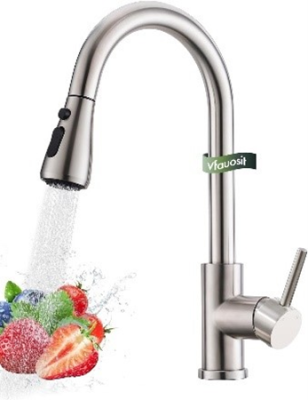
Product images from left to right: BASDEHEN, KICIMPRO, VFAUOSIT
Reference: CPSC recall announcements
Recall date: June 26, 2025
This recall involves Boyro Baby’s baby walkers, model number US-B01. The plastic walkers were sold in black, blue and gray with five levels of height adjustments. They have a black or gray rotating seat, a matching footpad, six wheels and four removable toys (an owl, a flower, an arch with a ball and a three-button panel that plays music and lights up.) “Ready To Ride” appears on a label on one of the walker’s legs and the height-adjustment buttons are on another leg. “Boyro Baby” and the model number are printed on the tracking label, located under the seat cushion. The baby walkers’ brake pads contain levels of lead that exceed the federal lead content ban that are prohibited in children’s products by the Federal Hazardous Substances Act.
Consumers should stop using and disassemble the recalled baby walkers immediately and contact Boyro Baby for instructions on receiving a full refund. Consumers will be asked to destroy the disassembled baby walker and email three photos of the destroyed product to boyrobaby@outlook.com. Once the three photos have been received, Boyro Baby will issue a refund. Boyro Baby and Amazon are contacting all known purchasers directly.
Health care providers should:
- Raise awareness among parents about these products.
- Consider testing children for lead exposure from these and other sources.
For more information visit the Consumer Product Safety Commission recall announcement.
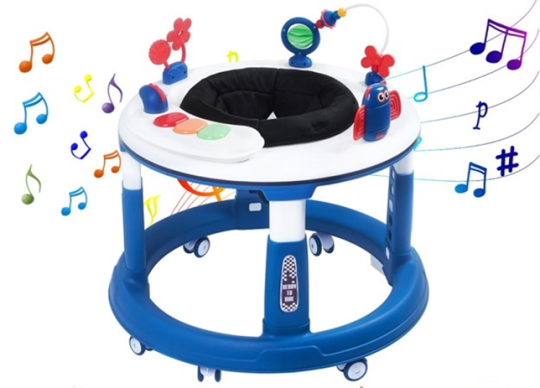
Product image of recalled item
Reference: CPSC recall announcement
Recall date: July 10, 2025
This recall involves SPPTTY kids bicycles. The bicycles are pink with brown seat covers, brown handlebars, brown pedals and brown baskets and were sold in 14-inch and 18-inch sizes. The brand “SPPTTY” and “New Sport Bike” are printed on the downtube. Multiple components of the children’s bicycles contain levels of lead that exceed the federal lead content ban, posing a lead poisoning hazard to children. In addition, the black paint on the bicycle pumps contains lead that exceeds the federal lead paint ban. The bikes were sold through Walmart.com from August 2024 through December 2024 for about $85.
Consumers should stop using the recalled children’s bicycles immediately and contact Shenzhen Yihuachuang Technology for a full refund. To receive a refund, consumers should dismantle the bicycles, take a photo, and send the photo by email to lishkjie@163.com. After submitting proof of destruction, consumers should dispose of the recalled bike.
Health care providers should:
- Raise awareness among parents about these products.
- Consider testing children for lead exposure from these and other sources.
For more information, visit the Consumer Product Safety Commission recall announcement.
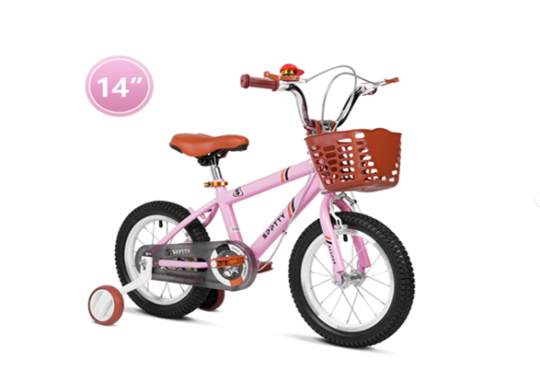
Product image of recalled bike
Reference: CPSC recall announcement, CDC Childhood Lead Poisoning Prevention Program
Recall date: July 23, 2025
W.W. Industrial Group, Inc., NY is recalling Parashore Pear Slices in juice, 15 oz, because they have the potential to be contaminated with elevated levels of lead and cadmium. The recalled product is packaged in a 15oz can and labeled as PARASHORE Pear Slices in Juice, 15oz (425 g), UPC#704817164237. The specific lot found positive for heavy metals was Lot 3700/01172 6122J, Prod: 02/19/2024, Best by 2/19/2027. The heavy metal contamination was discovered via sampling by the Maryland Department of Health. Product was distributed through Grocery Outlet stores in California and other Grocery Outlet stores across the US.
Consumers who have purchased Parashore Pear Slices in Juice 15oz (425 g) should not consume the products and are urged to discard in the trash or return them to the place of purchase for a full refund. Consumers with questions may contact the company at 516-676-9188 Monday to Friday 10AM – 4PM EST.
Health care providers should:
- Raise awareness among parents about these products.
- Consider testing children for lead exposure from these and other sources.
For more information, visit the FDA recall announcement.


Product image: front and back of recalled item
Reference: FDA recall announcement, CDC Childhood Lead Poisoning Prevention Program
Announcement date: August 13, 2025
The U.S. Food and Drug Administration (FDA) is warning retailers and consumers not to sell or use certain imported cookware that may leach significant levels of lead (Pb) into food. FDA could not identify and contact the distributor or responsible party to facilitate a recall, so this product may still be sold as cookware in retail stores.
FDA Recommendation
- Consumers should check their homes for the products listed in the FDA announcement and throw away any cookware that may be able to leach lead into food when used for cooking or food storage.
- Do not donate or refurbish this cookware.
- Consumers who have concerns about lead exposure or elevated levels of lead should contact their health care provider.
Health care providers should:
- Raise awareness among parents about these products.
- Consider testing children for lead exposure from these and other sources.
Reference: FDA recall announcement, CDC Childhood Lead Poisoning Prevention Program
Announcement date: September 15, 2025
Through product testing by state programs and confirmed by the FDA, the FDA has determined that the ground cinnamon products listed in this table on the FDA announcement webpage contain elevated levels of lead and that exposure to these products may be unsafe. The FDA is advising consumers to throw away and not to buy these ground cinnamon products.
FDA Recommendations
- The FDA is advising consumers to stop using and dispose of the ground cinnamon products listed in the table in the FDA announcement.
- Consumers should not eat, sell, or serve ground cinnamon products listed in the table in the FDA announcement and should discard them.
- These products have a long shelf life. Consumers should check their homes and discard these products.
- If there’s suspicion that someone has been exposed to elevated levels of lead, talk to your healthcare provider. Most people have no obvious immediate symptoms of lead exposure.
- Consumers who have symptoms should contact their health care provider to report their symptoms and receive care. To report a complaint or adverse event (illness or serious allergic reaction), visit Industry and Consumer Assistance.
Health care providers should:
- Raise awareness among parents about these products.
- Encourage parents to immediately stop using the recalled products and throw them away.
- Consider testing children for lead exposure from these and other sources.
References: FDA announcement, CDC Childhood Lead Poisoning Prevention Program
Recall date: September 16, 2025
Sprout Organics has initiated a voluntary recall of one lot of Sprout Organics® Sweet Potato Apple and Spinach because it may contain elevated levels of lead. The product, a 3.5-ounce pouch, was sold in Walgreens and some independent stores in the US South region with most sales occurring between September and December 2024. The product was not sold in any other large grocery chain besides Walgreens.
If consumers have product matching the following description in their possession, they should return it to their local store for a full refund. The lot code and expiration date are printed on the bottom strip on the back of the pouch.
Product name: Sprout Organics® Sweet Potato Apple and Spinach 3.5 oz pouch
Purchased from: Walgreens and independent stores in US South region
Lot Code: 4212
Expiration date: 10/29/2025
Consumers with questions should contact the company at 510-833-6089 Monday through Friday 9 am to 5 pm Pacific Time or by email at Info@sproutorganics.com.
CDC encourages health care providers to:
- Raise awareness among parents about these products.
- Encourage parents to immediately stop using the recalled products and throw them away. Consumers with questions can contact the company by calling 510-833-6089 Monday through Friday 9 am to 5 pm Pacific Time or by email at Info@sproutorganics.com
- Consider testing children for lead exposure from these and other sources.


Product images: Front and back of recalled item
References: FDA recall announcement, CDC Childhood Lead Poisoning Prevention Program
Recall date: September 26, 2025
SLR Food Distribution of Hicksville, NY is recalling Wise Wife brand Cinnamon, because it has the potential to be contaminated with elevated levels of lead. Wise Wife brand Ground Cinnamon was distributed to retailers located (NJ, NY, FL, MD, MN, OK, OH) between 02/15/2024 and 06/28/2025. The recalled product is identified as Wise Wife brand and packaged in a 1.76oz (50g) clear plastic jar with a black lid. UPC 0 688474 302853 is printed on the back label. The recall was the result of an analysis conducted by the United States Food and Drug Administration that revealed the product contained elevated levels of lead. The last sales order of the product was distributed on 6/28/25 and the product is no longer being sold by SLR Food Distribution, Inc.
Consumers who have purchased this product are urged to return it to the place of purchase for a full refund. Consumers with questions may contact the company at 516-437-3782 EST or by email at slrfoods.com
CDC encourages health care providers to:
- Raise awareness among families about this product.
- Advise consumers to immediately stop using the recalled cinnamon and dispose of it safely.
- Consider blood lead testing for children who may have consumed the recalled cinnamon or been exposed to other potential sources of lead.


Product images: Front and back of recalled item
References: FDA recall announcement, CDC Childhood Lead Poisoning Prevention Program
Recall date: October 2, 2025
This recall involves Evermore Surprise Eggs with yellow, pink or green wrap. The Surprise Eggs are gold and contain seven different toys including a toy airplane. The toy airplane inside the egg contains levels of lead that exceed the federal lead content ban. The toys were sold at 7-Eleven, Horizon, Speedway and Murphy stores nationwide from March 2025 through April 2025 for about $10.
Consumers should stop using the Surprise Eggs immediately and contact Motion Design for a refund. Consumers should destroy the toy airplane, send a photo of the destroyed airplane to support@in-motion-design.com, and then dispose of the airplane in accordance with local and state laws.
Health care providers should:
- Raise awareness among parents about this product.
- Consider testing children for lead exposure from this and other sources.
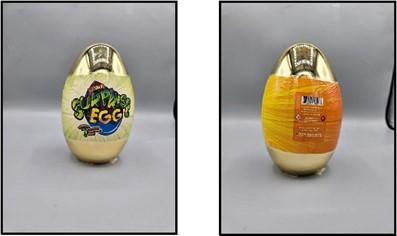
Product images: Front and back of recalled item in yellow wrap
References: CPSC recall announcement
Recall date: November 19, 2025
Shata Traders Inc of Brooklyn, NY is recalling Chef Brand Milk Pan 24 cm, because it has the potential to be contaminated with significant levels of lead (Pb) which may leach into food.
The Chef Brand Milk Pan 24 cm product was distributed in NY, NJ, CT, MD, VA and MA areas. The product is sold as 6Pcs/Box which are sold individually at retail.
If you have purchased Chef Brand Milk Pan 24cm, you are requested to stop using the product and return it to the retail store from where you have bought it for a full refund.
For questions and concerns please contact (718) 369-7000 ask for Mahboob Rahman.
CDC encourages health care providers to:
- Raise awareness among families about this product.
- Advise consumers to immediately stop using the recalled cinnamon and dispose of it safely.
- Consider blood lead testing for children who may have consumed the recalled cinnamon or been exposed to other potential sources of lead.
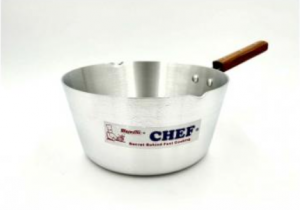
Product image of recalled item
References: FDA recall announcement, CDC Childhood Lead Poisoning Prevention Program
Recall date: December 9, 2025
TBC Distribution Corporate of Brooklyn, NY is recalling Lucky Foods brand Cinnamon Powder 40g, best before date 15.09.2027 because it has the potential to be contaminated with elevated levels of lead.
Lucky Foods brand Cinnamon Powder was distributed to retailers such as, grocery stores, convenience stores, super markets, delis, bakeries, and restaurants located in California, Florida, Georgia, Illinois, Maryland, Michigan, North Carolina, New Jersey, New York, Ohio, Oregon, Pennsylvania, South Carolina, and Texas between 04/11/2025 and 09/01/2025. The product is packaged in a vacuum or modified atmosphere 40g pouch with a brown label indicating Lucky Foods brand at the top of the pouch.
Consumers are urged not to consume the product and may contact the company at 718-444-5556, Monday - Friday, from 8:00AM -5PM Eastern time.
CDC encourages health care providers to:
- Raise awareness among parents about these products.
- Encourage parents to immediately stop using the recalled products and return it to the place of purchase for a full refund. Consumers with questions can contact the company by phone (718) 444-5556
- Consider testing children for lead exposure from these and other sources.

Product image of recalled item
References: FDA recall announcement, CDC Childhood Lead Poisoning Prevention Program
Recall date: December 12, 2025
Description:
Town Food Service Equipment Co., Inc. of Brooklyn, NY is recalling aluminum saucepans, because it has the potential to be contaminated with lead (Pb) which may leach into food. The saucepans being recalled were distributed in AL, AR, AZ, CA, CO, FL, GA, IL, KY, LA, MA, MD, ME, MI, MN, MO, MS, NC, NJ, NM, NV, NY, OH, OK, PA, RI, SC, SD, TN, TX, UT, VT, WA, WV, Puerto Rico and Quebec City, Canada through its network of authorized food service equipment dealers, which include retailers, between January 1, 2023 and November 30, 2025.
Please note that per the FDA recall this product was not distributed in Virginia. However, it was distributed in multiple neighboring states.
The 4 sizes of aluminum saucepans being recalled have capacities ranging from 1 quart to 3 quarts, have indented graduations on the interior, and a plated steel handle riveted to the body. Visit the FDA recall announcement for a table containing the item descriptions and SKUs.
Remedy:
Consumers who have purchased and are in possession of any of the items are urged to return them to the place of purchase for a full refund. Consumers with questions may contact Town Food at 718-388-5650 Mon-Fri 9AM-5PM EST, or email our recall coordinators at recall@townfood.com. Updates on the recall will be posted on our recall webpage: https://townfood.com/recall-alum/
CDC encourages health care providers to:
- Raise awareness among parents about these products
- Encourage parents to immediately stop using the recalled products and return them to the place of purchase for a full refund (Consumers with questions can contact the company by calling (718) 388-5650 or emailing recall@townfood.com)
- Consider testing children for lead exposure from these and other sources



Product images of recalled item. For additional product images visit the FDA recall announcement.
References: FDA recall announcement, CDC Childhood Lead Poisoning Prevention Program
Recall date: December 22, 2025
Description:
Handelnine Global Limited d/b/a Navafresh is voluntarily recalling Lot Numbers CAM040 & CALO79-N of Rheumacare Capsules by Virgo UAP Pharma Pvt. Ltd. (Virgo) to the consumer level. In test conducted by the Food and Drug Administration the product has been found to contain lead at levels up to 11,100 ppm, which are higher than permissible levels.
The product is used to reduce joint pain and is packaged in white plastic containers bearing the label of the brand Rheumacare Capsules. The affected Rheumacare Capsules lots include the following CAM040 & CALO79-N. Product was distributed nationwide via www.navafresh.com.
Remedy:
Handelnine Global Limited is notifying its distributors and customers by email of the recalled product. Consumers that have product which is being recalled should stop using and discard the product immediately. A refund shall be issued to consumers who had placed orders for the product.
Consumers with questions regarding this recall can contact Mr. Ankit Mota at Handelnine Global Limited by phone number +1 442-223-0999 or e-mail address legal@handelnine.com on Monday to Friday from 10 am to 5 pm, GMT (UK time). Consumers should contact their physician or healthcare provider if they have experienced any problems that may be related to taking or using this drug product.
CDC encourages health care providers to:
- Raise awareness among parents about these products.
- Encourage patients to immediately stop using the recalled drug.
- Consider testing for lead exposure from these and other sources.

Product image of recalled item
References: FDA recall announcement, CDC Childhood Lead Poisoning Prevention Program
Recall date: January 8, 2026
Description:
Gusto Group Inc. of Paterson, NJ is recalling [Klong Kone] Shrimp Paste (Klong Kone) '454 G. (1 LBS)' and ‘910 G. (2 LBS)’ because it has the potential to be contaminated with elevated levels of lead. The recalled product was directly distributed to the two retailers listed below, located IA and NJ , between April 2023 to December 2023 There were no online sales. For more information about the retailers, please visit the recall announcement.
The recalled [Klong Kone] Shimp Paste (Klong Kone) “454 G. (1 LBS)” and “910 G. (2 LBS),” is packaged in a white plastic jar with a red cap. The product is a dark-colored paste with a salty flavor. The product was Packed and Distributed By: P. Prateepthong 2000, Product of Thailand.
The recalled product was sold in two sizes:
- [Klong Kone] Shrimp Paste (Klong Kone) '454 G. (1 LBS)' , with UPC: 8853142000313, Product Code: DPA159
- [Klong Kone] Shrimp Paste (Klong Kone) '910 G. (2 LBS)' , with UPC: 8853142000320, Product Code: DPA161
Remedy:
Consumers who purchased the recalled [Klong Kone] Shrimp Paste (Klong Kone) should return the product to the place of purchase for a full refund. For any questions, please contact the company at (862) 264-6774 or via email at ings@gustofood.com. Our representatives are available Monday through Friday, 8:30 AM – 5:00 PM Eastern Time (ET).
CDC encourages health care providers to:
- Raise awareness among parents about these products
- Encourage parents to immediately stop using the recalled products and return them to the place of purchase for a full refund (Consumers with questions can contact the company by calling (862) 264-6774 or via email at ings@gustofood.com.)
- Consider testing children for lead exposure from these and other sources

Product images of recalled item.
References: FDA recall announcement, CDC Childhood Lead Poisoning Prevention Program

